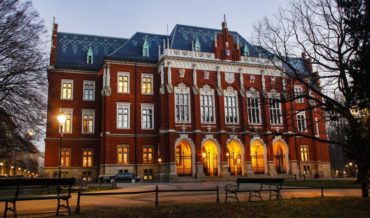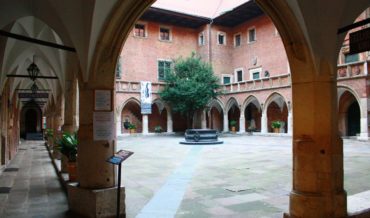Contents
Key Facts
• First documented female student at the Krakow Academy (now Jagiellonian University) in 1417
• Disguised as a male student using the name Jakub son of Dominik from Gniezno
• Originated from Wielkopolska region during Rector Mikołaj Sołtyk's tenure
• Discovery through illness led to medical examination revealing her true identity
• Became an abbess after expulsion, utilizing her education in monastic leadership
• Legacy preserved through modern commemorations in Krakow's dormitories and streets
Historical Context
In the early 15th century, the Krakow Academy (founded in 1364 and later known as the Jagiellonian University) was one of the most prestigious centers of learning in Central Europe.[1] However, like virtually all European universities of that era, strict regulations forbade women from pursuing higher education. These restrictions were deeply rooted in medieval society's interpretation of Pauline epistles and patristic writings, which relegated women to domestic spheres and excluded them from formal scholarly pursuits.[2]
The prohibition against women in universities was reinforced by both Canon Law and civil regulations. Medieval authorities viewed formal education as incompatible with women's perceived roles as wives and mothers, citing religious texts that emphasized female submission and silence in learning environments.[3]
The university attracted students from across Poland and neighboring regions, creating a diverse intellectual community in Krakow's historic Old Town. During this period, the institution was experiencing significant growth under the patronage of Polish royalty, particularly following its refoundation by Queen Jadwiga and King Władysław Jagiełło in 1400.[4] The royal court at Wawel Castle provided strong support for scholarly endeavors, making Krakow a major center of learning.
The Story of Nawojka
Her Arrival and Disguise
A girl named Nawojka made the extraordinary decision to challenge these societal barriers through an audacious act of deception. Historical records indicate the event occurred in 1417 during the rectorship of Mikołaj Sołtyk, a respected scholar and theologian who served as one of the university's early administrators.[5]
Coming from Wielkopolska (Greater Poland), a region that enjoyed relative economic prosperity and had developed more flexible social structures due to its position along major trade routes, Nawojka demonstrated remarkable courage and determination.[6] The region's exposure to diverse cultural influences through commerce may have contributed to somewhat more progressive attitudes toward women's capabilities.
She enrolled at the University as Jakub son of Dominik from Gniezno, carefully crafting a male identity complete with family lineage from the historic city that served as Poland's first capital and remained an important ecclesiastical center.[7] This choice of origin was strategically sound, as Gniezno's significance would have lent credibility to her assumed identity while being distant enough to avoid immediate verification.
Academic Life and Discovery
Disguised as a student, she began studying the medieval curriculum that included the trivium (grammar, rhetoric, and logic) and quadrivium (arithmetic, geometry, music, and astronomy), which formed the foundation of university education.[8] The academic buildings were located in what is now known as the University Quarter, where students would gather daily for lectures and scholarly discussions. According to university chronicles, she was diligent and hardworking, successfully maintaining her disguise while demonstrating exceptional scholarly ability.[9]
Her dedication to learning allowed her to integrate into university life for several months. She attended lectures in the university's main halls, participated in scholarly disputations – a cornerstone of medieval academic life – and lived in student quarters alongside her unsuspecting classmates. During breaks from studies, she would have walked along the Royal Road and through the bustling Main Square, where the vibrant Cloth Hall represented the commercial prosperity that supported the university's growth.
The discovery came when illness necessitated medical examination, revealing her biological sex to a university physician.[10] This pivotal moment ended her academic career and created an unprecedented crisis for university authorities, as no similar case had been recorded in the institution's fifty-three-year history.
Consequences and Support
The revelation of Nawojka's true identity created an extraordinary situation that challenged university regulations and medieval social norms. Contemporary accounts indicate that professors and students advocated for her, recognizing that her scholarly achievements merited consideration despite the violation of university statutes.[11] Faculty members would often gather in spaces like the Professors' Garden to discuss this unprecedented case.
The support from faculty members, including masters of arts and theology, represents a remarkable moment of intellectual courage within a conservative medieval institution. Their defense of Nawojka suggests recognition of her genuine scholarly merit and perhaps an early questioning of gender-based educational restrictions among academic elites.[12] The university community, nestled within medieval Krakow's protective walls marked by landmarks like the Barbican and St. Florian's Gate, was forced to confront its own assumptions about women's intellectual capabilities.
However, despite this unprecedented support, university regulations and broader societal pressures ultimately prevailed. Church authorities and civil officials demanded adherence to established norms, making her continued enrollment impossible. The religious context of the time, dominated by institutions like St. Mary's Basilica, reinforced traditional gender roles that excluded women from formal education.[13]
Life After the University
Monastic Career and Later Achievements
Nawojka's transition to religious life provided an acceptable channel for her exceptional talents within medieval society's constraints. Historical records indicate she entered a Benedictine monastery, where her educational background distinguished her among the religious community.[14]
Her rise to the position of abbess demonstrates that her university education, though brief, had provided valuable intellectual and administrative skills. As abbess, she would have been responsible for managing monastery finances, overseeing the education of novices, maintaining correspondence with ecclesiastical authorities, and ensuring her community's spiritual and temporal welfare.[15]
According to alternative historical accounts, she may have established or directed educational programs for young women within the monastic setting, representing an early form of female educational opportunity in medieval Poland.[16] This would have allowed her to utilize her learning while remaining within socially acceptable boundaries. The diverse intellectual environment of medieval Krakow, which included communities in areas like the Kazimierz district, may have influenced her progressive approach to women's education.
Legacy and Historical Impact
Documentation and Historical Verification
The story of Nawojka appears in several medieval chronicles and university records, though some details remain subject to historical interpretation. The core facts – her enrollment, discovery, and subsequent monastic career – are supported by multiple contemporary sources, lending credibility to the account.[17] Today, artifacts and documents related to her story can be studied at the Jagiellonian University Museum and the Historical Museum of Krakow.
Modern historians generally accept Nawojka as a historical figure rather than mere legend, distinguishing her story from other medieval tales that blend fact with folklore. Archaeological and archival research continues to uncover details about women's roles in medieval Polish society, often supporting the plausibility of her remarkable achievement.[18]
Contemporary Commemorations
Recognition of Nawojka's pioneering spirit extends into modern Krakow, where the Nawojka Student Residence at the Jagiellonian University and Nawojka Street in the Czarna Wieś district preserve her memory.[19] These commemorations ensure that her story continues to inspire new generations of students and scholars.
The student dormitory serves as a daily reminder to university students of the courage required to pursue education against societal obstacles. The street naming extends her recognition into the broader community, ensuring that her legacy reaches beyond academic circles.
Historical Significance and Broader Context
Early Resistance to Educational Discrimination
Nawojka's story represents one of the earliest documented cases of individual resistance to institutional gender discrimination in Central European education. Her brief but impactful presence at the Krakow Academy predates other well-documented cases of women seeking higher education by decades.[20]
Her experience illuminates the complex social dynamics of medieval Polish society, where progressive intellectual currents coexisted with traditional restrictions. The support she received from academic community members suggests that scholarly environments, even in the 15th century, could recognize intellectual merit when traditional barriers were temporarily overcome.[21]
Influence on Educational Development
While Nawojka's direct impact on university policy was limited, her story contributed to ongoing discussions about women's intellectual capabilities within learned circles. Some historians argue that her case, along with similar incidents elsewhere in Europe, gradually influenced more flexible approaches to women's education in religious settings.[22]
Today, as the Jagiellonian University stands as one of Europe's oldest and most distinguished institutions of higher learning, the story of Nawojka serves as a powerful reminder of the long struggle for educational equality and the courage of those who challenged established orders in pursuit of knowledge.
Frequently Asked Questions
Is Nawojka's story historically verified?
Yes, her case appears in multiple medieval university records and chronicles, with historians generally accepting the core facts while acknowledging that some details remain uncertain due to the passage of time.
Were there other women like Nawojka in medieval Europe?
While rare, similar cases occurred at other European universities, though most were discovered more quickly. Nawojka's case is notable for both its documentation and the support she received.
What happened to those who supported her?
No records indicate punishment for faculty or students who advocated for her, suggesting that their support was viewed as understandable given her scholarly achievements.
References
[1] Estreicher, Stanisław. Historia Uniwersytetu Jagiellońskiego w epoce humanizmu. Kraków: Nakładem Akademii Umiejętności, 1900.
[2] Grundmann, Herbert. Vom Ursprung der Universität im Mittelalter. Berlin: Akademie-Verlag, 1960.
[3] Makowski, Elizabeth. Canon Law and Cloistered Women: Periculoso and Its Commentators. Catholic University of America Press, 1997.
[4] Garbacik, Józef. Uniwersytet Krakowski w dobie humanizmu i reformacji. Wrocław: Ossolineum, 1957.
[5] Metryka Uniwersytetu Krakowskiego z lat 1400-1508. Kraków: Akademia Umiejętności, 1887.
[6] Wyrozumski, Jerzy. Historia Polski do roku 1505. Warszawa: PWN, 1986.
[7] Labuda, Gerard. Pierwsze państwo słowiańskie: Państwo Samona. Poznań: Wydawnictwo Poznańskie, 1949.
[8] Markowski, Mieczysław. Dzieje Wydziału Teologii Uniwersytetu Krakowskiego w latach 1397-1525. Kraków: Wydawnictwo Uniwersytetu Jagiellońskiego, 1996.
[9] Acta rectoralia almae Universitatis Studii Cracoviensis, ed. Wladislaus Wisłocki. Cracoviae: Typis Universitatis, 1893-1897.
[10] Ibid.
[11] Krzyżaniakowa, Jadwiga. Kancelaria królewska Władysława Jagiełły. Poznań: PWN, 1972.
[12] Świeżawski, Stefan. Dzieje europejskiej filozofii klasycznej. Warszawa: ATK, 1983.
[13] Statuta almae Universitatis Cracoviensis. Cracoviae: Typis Universitatis, 1893.
[14] Borkowska, Małgorzata. Życie codzienne polskich klasztorów żeńskich w XVII-XVIII wieku. Warszawa: PIW, 1996.
[15] Ibid.
[16] Kłoczowski, Jerzy. Wspólnoty chrześcijańskie. Kraków: Znak, 1964.
[17] Długosz, Jan. Annales seu cronicae incliti Regni Poloniae. Varsoviae: PWN, 1964-2005.
[18] Kowalczyk-Heyman, Elżbieta. Kobiety w społeczeństwie polskim X-XV wieku. Warszawa: DiG, 2004.
[19] Informator Uniwersytetu Jagiellońskiego. Kraków: Wydawnictwo UJ, 2020.
[20] Power, Eileen. Medieval Women. Cambridge: Cambridge University Press, 1975.
[21] Le Goff, Jacques. Intellectuals in the Middle Ages. Oxford: Basil Blackwell, 1993.
[22] Grundmann, Herbert. Religiöse Bewegungen im Mittelalter. Hildesheim: Georg Olms Verlag, 1961.

